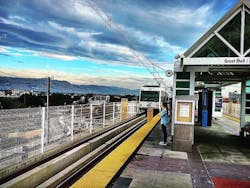Driving Change at VTA
Santa Clara Valley Transportation Authority (VTA) General Manager Nuria Fernandez, originally from Panama, came to the United States to study engineering. After attending Bradley University in Peoria, Illinois, to get her degree in civial engineering, she went to the city of Chicago’s Department of Public Works.
After several years, she moved on to become assistant director of the first expansion at O’Hare International Airport. “I was responsible for all of the local roads, access to the airport and airside runway extensions,” Fernandez explained. And when that segment was coming to an end, she was approached by the chairman of the Chicago Transit Authority (CTA).
CTA had been experiencing a huge backlog of its capital program. The state had provided them with a million dollars that they were getting ready to take away if the capital program was not implemented.
“I was brought on board, I organized the team, and not only did we reduce the backlog … but we put in place a capital program that was based on engineering condition assessment of all of CTA’s transit assets,” said Fernandez. “That was the beginning of creating a stable capital program with a stable source of funds.”
While at CTA, Fernandez said she met Louise Frankel Stoll, who at the time was second in command at O’brien-Kreitzberg Inc., one of the largest engineering and construction management firms in the United States at the time. “She wanted to open up an office in Chicago … someone referred her to me because both of us were members of the Women’s Transportation Serminar, WTS.
“I came in, gave her some suggestions and we became friends.”
Frankel Stoll was tapped by President Bill Clinton to be assistant secretary of the Department of Transportation in 1993. Frankel Stoll called Fernandez and asked her to come work at the DOT.
Fernandez left Chicago and went to the DOT, in charge of budget and programs over all of the modal administrations. She explained, “That was working on recent technology projects with the Maritime Administration, the Federal Transit Administration, the Federal Railroad Administration, Federal Highway Administration and the Federal Aviation Administration.
“The time span was when the government, the Department of Defense, was turning a lot of its research and a lot of its technology for civilian use,” she said. The department had all of this great information and a lot of it could be used by the private sector to develop it further.
“We were looking at a lot of that technology and its application for transportation,” Fernandez said. “That gave me an opportunity to understand that technology work with offices in the Department of Defense work with the Department of Energy, that also had a lot of transportation funding and work with the Department of Commerce.”
In 2001 she joined the private sector, working at EarthTech Contracting, then went back to Chicago to run O’Hare International Airport. Following that she went to work with CH2M to work on transportation-related projects around the world until she was tapped by Governor Andrew Cuomo to be chief operating officer of the New York Metropolitan Transportation Authority.
It was while she was at the MTA that she was contacted by outgoing VTA General Manager Michael Burns, who told her about the opportunity opening up at VTA upon his retirement.
At the time, VTA was entering its second year of the Bay Area Rapid Transit construction program and with her background in project management, she had done major construction. She also had the background of working at the federal government, and it was important for VTA to have a good relationship with the federal government because it had received a full funding grant agreement and there were high expectations that VTA would be expanding another six miles, which would entail pursuing another full funding grant agreement.
When Fernandez started in public transportation, she said she didn’t understand the back story of what made a public transportation agency successful. “All I knew about public transportation was that there were buses and trains,” she said. “I didn’t understand … what made a public transportation agency successful and all the other challenges that are seen to those of us that use it …”
The broad experience has given her the understanding of where policies came from, how they work and how they are implemented. “When I was at the FTA, we were getting ready to reauthorize ISTEA [Intermodal Surface Transportation Efficiency Act of 1991] so all those programs and policies — I was there.
“I had an understanding of that side of how the sausage is made. Then working in the private sector, working for clients who were looking for funding or building extensions of their own systems in the United States and around the world.”
